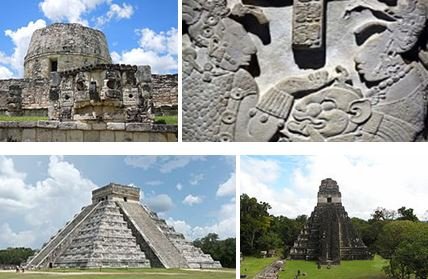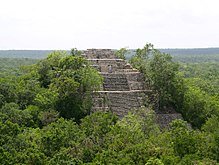The Maya Civilization: Timeline

Maya Civilization
Beginning as far back as the second millennium BCE, the Maya civilization was a colossal force to be reckoned with in Mesoamerica for close to 3,000 years. This Central American civilization could boast of powerful city-states like Mirador, Uzmal, Kaminaljuyu, and Chichen Itza.
Magnificent stone structures and pyramids, which were often used for religious purposes, often graced the landscape of those cities. Archaeologists reason that the Maya civilization was perhaps the only civilization in the Americas to have an advanced written language. This feat of theirs, as well as many more, was part of the reason why the Mayans were so dominant in the region until the arrival of the Spanish in 1519 CE.
When exactly did the Maya civilization start and end? How did the Maya culture evolve over those centuries of years? To discover the answers to these questions, World History Edu presents a complete timeline of the Maya Civilization below:
Olmec (1200-1000 B.C.)
11,000 B.C. – Maya highlands and lowlands receive the first hunter-gatherers.
3,114 B.C. – According to Mayans in the region, the world is created.
2600 B.C. – The Maya civilization is born, as the people become more organized and corporate among themselves.
Early Pre-classic Maya (1800-900 B.C.)
2000 B.C. – The Olmec civilization emerge as the dominant group of people on the Mexican gulf coast; and from those people, emerge the Maya civilization along with a host of farming villages.
1500 B.C. – The Olmec civilization continues to develop
1000 B.C. – Relatively advanced ancient settlements like Chalchuapa and Copan begin to have huge impact in the region.
Middle Pre-classic Maya (900-300 B.C.)
700 B.C. – The Mayans develop writing.
600 B.C. – Large buildings and monuments spring up in cities such as El Mirador; farming and internal trade intensifies, which result population boom.
550 B.C. – A thriving settlement at Tikal spring up.
400 B.C. – The culture and economy appears to be steadily progressing in the region, solar calendars (carved into stones) emerge properly.
Late Pre-classic Maya (300 B.C. – 250 A.D.)
300 B.C. – As the culture flourishes, a clear social structure emerges with the kings and nobles firmly placed at the top of the social and economic hierarchy.
100 B.C. – The famous city-state of Teotihuacan (located in the Valley of Mexico) comes to be the cultural, economic and religious hub of the region.
50 B.C. – Magnificent pyramids and stone structures (i.e. temples, royal courts and community centers) begin to be constructed, many of them in the city of Cerros.
100 A.D. – Cities like Cerros and other culturally significant cities of the Olmecs begin to fade away
Early Classic Maya (250 A.D. – 600 A.D.) – the start of Maya’s golden age

Maya Civilization | Calakmul was a very city-state during the classic period
400 A.D. – Teotihuacan, a city-state, introduces new ways of doing things, in terms of religious practices and language; by so doing, they begin to make rightful claim as the most dominant city in the Maya highlands.
500 A.D. – With the decline of Teotihuacan, the Maya city of Tikal emerges strong and prosperous, poaching the resources from Teotihuacan. New forms of barbaric and human sacrifices also emerge in Tikal, which in turn spurs Tikal to subjugate surrounding cities.
560 A.D. – Tikal’s dominance in the region is ended by an alliance formed by other city-states, including the city-state of Calakmul.
Late Classic Maya (600 A.D. – 900 A.D.)
600 A.D. – Teotihuacan and its people vanish of the face of the earth for reasons unknown to this day. This paves the way for the civilization at Tikal, which can boast of about half a million people, to lead Mesoamerica again.
600 A.D. – Leaders of Caracol steer their city-state into a very powerful force.
683 A.D. – The powerful and revered Emperor Pacal is buried. Pacal lived to the ripe age of 80.
751 A.D. – The Mesoamerica region is plunged into chaos and decline as inter-city wars become the norm of the day. As a result, trade and economic growth reverse, leaving the region in a deplorable situation.
867 A.D. – Tikal declines sharply**; the city is no longer properly organized to be able to muster resources and the desire to put up buildings. By 900 A.D. the city, along with its neighboring southern lowland cities, becomes a ghost city, ushering in the end of the Classic Period of the Maya civilization.
* * As is common with the decline of ancient civilizations, the reasons for the decline of Tikal and Teotihuacan are a complete puzzle to archeologists to this day.
Post-Classic Maya (900-1500)

During the post-classic Maya period, Chichen Itza was the most dominant city in the northern Maya region
900 A.D. – 1200 A.D. – The cities in the northern part of Yucatán thrive for a few centuries. Most prominent of those cities was the city-state of Chichen Itza, which dominated the region for more than two centuries.
1200 A.D. – Population and economic activities in northern Maya dwindles, and ultimately, those cities become uninhibited.
1224 A.D. – A few decades after the demise of cities in the north, the Toltecs leave, in hordes, the city of Chichén Itzá. Those that remain are joined by the likes of the Uicil-abnal (they later come to be known as the Itzá.
1243 A.D. – For reasons unknown to this day, the people of Uicil-abnal (i.e. the Itzá) abandon Chichén Itzá.
1250 – Chichen Itza is abandoned.
1263 A.D. – The Itzá people pull resources together and build the city of Mayapán. For the next two centuries, Mayapán grows tremendously and becomes the cultural and economic hub of Yucatán.
1441 A.D. – Leaders of Mayapán are toppled; the ensuing political instability wreaks immense havoc, forcing the inhabitants to abandon the city a few decades later.
1462 A.D. – The demise of its capital – Mayapán – deals a huge blow to unity of Yucatán. The kingdom fractures into more than a dozen warring states.
The divisions among the Mayapan leave the region unprepared for the arrival of the Spanish conquistadors.
Colonial period (1500-1800)

Maya Civilization Timeline | Spanish Conquistadors (from left to right): Pedro de Alvarado (c. 1485-1541) and Hernán Cortés (1485-1547)
1511 A.D. – Gonzalo Guerrero, a Spaniard sailor, encounters problems at sea. Guerrero is shipwrecked and luckily makes his way to coast of Yuncatán. In order to survive, he embraces the Mayan culture and even gets married to Mayan noble girl. Guerrero would go on to be staunch supporter of the Maya in their resistance to Spanish control in the region.
1517 A.D. – A Spanish ship, led by Hernandez de Cordoba, comes into contact with Yucatán. The conquistador explores the region. And as expected, the two sides begin warring and Cordoba, as well as numerous others, perishes in the battle.
Did you know: The Maya civilization does not only have to contend with the superior military prowess of the Spanish, but also very deadly diseases (i.e. smallpox, measles and influenza) brought from Europe to their shores? Those diseases would wipe out more than 90% of the native population in the region.
1519 – The famous Spanish conquistador Hernán Cortés ventures into Yucatán region.
1524 – The Itzá remains one of the few places yet to be conquered by Hernán Cortés.
1541 – The Maya people and the various city-states in the region capitulate to the might of Spanish Empire.
1542 – Mérida in Yucatán is made the capital city of Spain’s new territories.
1695 – Lost in the thick jungle, Spanish priest Father Avedano stumbles upon the ruins of Tikal.
1712 – People living in the Chiapas highlands revolt against the Mexican government*.
1742 – The brutal system of Ecomienda is abolished. The system encouraged wealthy Spanish barons in the region to force the natives into forced labor.
*The friction between Chiapas highlanders and the Mexican government lasted up until the 1990s.
Independent Mexico (1821 to present)
1821 – Mexico secures its independence from Spain. With Mexico’s independence in 1821, Maya are granted better protection compared to the ones they received during Spanish rule.
1822 – Following the publication of Antonio del Rio’s explorations, more and more Europeans become curious about the lost ancient cities of the Maya civilization.
1839 – Explorers from the United States and England embark on explorations into deep regions of Maya. The revelations of American lawyer John Lloyd Stephens and English scholar Frederick Catherwood raise greater interest in Maya civilization and culture.
1847 – The Yucatán marshal a strong and fierce revolt against the Mexican government during the War of the Castes. Yucatán were this close to vanquishing the Mexican army.
1850-1860 – Britain secretly arms the Maya people as they cook up another rebellion against white settlers primarily in the region.
1864 – A discovery of an ancient jade plaque occurs; the plaque had the date 320 A.D.
1880 – Marginalization of the Maya people continues as the central government relegates them to horrific working conditions on plantations. By so doing, the Maya people begin to throw away their traditions and culture, some of which date back to 2000 BCE.
1910 – The Mexican Revolution occurs.
1946 – Following Giles Healey’s interaction with the natives at Bonampak, further revelations about the Maya civilization come up. Giles had the rare honor of being shown the magnificent wall paintings in Bonampak.
1952 – Led by Alberto Ruz, explorers and archaeologists discover Pascal’s tomb inside a Maya pyramid. This discovery dispels previously held notion that the pyramids in Maya were built for religious purposes, unlike the ones in ancient Egypt.
1960-1970s – Following the immense publicity about the various discoveries in the region, unscrupulous people begin to loot the region, stealing priceless Maya artefacts.
1992 – The region’s most celebrated export Rigoberta Menchu is awarded the Nobel Peace Prize. Menchu, a human/civil rights activist from Quinché Maya, was very effective in raising awareness of the plight and the sufferings of her people at the hands of death squads.

























